The AMD TRX40 Motherboard Overview: 12 New Motherboards Analyzed
by Gavin Bonshor on November 28, 2019 9:00 AM EST- Posted in
- Motherboards
- AMD
- MSI
- Gigabyte
- ASRock
- Asus
- TRX40
- Threadripper 3000
- Castle Peak
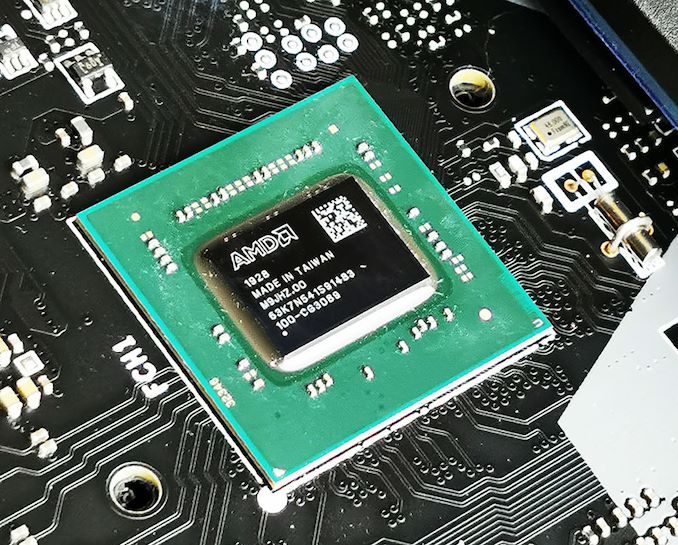
It's been a fruitful time for AMD's CPU team over the last year, with a lot of praise heaped on its current processor product stack. The launch of the new AMD Threadripper 3970X 32-core and the Threadripper 3960X 24-core processors has brought the brand new TRX40 chipset to market, and out of all the motherboard partners, there is a new chipset and 12 new motherboards to dissect. In this article, we'll be analyzing the 12 new boards, which as a priority feature enables a PCIe 4.0 x8 link between the CPU and chipset.
The AMD TRX40 Chipset Overview: PCIe 4.0 For HEDT
One of the most important innovations with AMD's switch to the 7 nm architecture was the inclusion of PCIe 4.0. It marked the first consumer hardware to feature PCIe 4.0, which made a huge talking point during the release of the X570 chipset for the Ryzen 3000 CPUs. For the new HEDT processors, we get a new platform, and AMD's new in-house designed TRX40 chipset also integrates PCIe 4.0. This also comes with a PCIe 4.0 x8 connection between the TRX40 chipset and the new AMD Threadripper 3000 processors, quadrupling the bandwidth compared to any competitor's design.
AMD leveraged GlobalFoundries 14nm to build the TRX40 chipset, which in a maximum I/O configuration, offers 16 downstream PCIe 4.0 lanes for peripherals. Like other AMD chipsets, motherboard vendors can select between these PCIe lanes and additional SATA ports, giving board makers some flexibility between PCIe and storage. Combined with the 56 free lanes from the CPU, motherboard makers have a maximum of 72 PCIe 4.0 lanes to work with in building their motherboards.
Another high point is lots of native support for USB 3.1 G2. Up to 12 USB 3.1 G2 ports are supported at the chipset level - this is a massive jump over X399 which supported just two natively. AMD's TRX40 chipset also has support for four USB 2.0, with extra USB 3.1 G1 available through additional controllers integrated into models. This is why some models opt to use USB 2.0 ports to complement the USB 3.1 G2 on the rear panel where required.
One big aspect motherboard vendors have been focusing on is the power delivery. The two new processors for launch day come in at an impressive 280 W TDP, with the newly announced Threadripper 3990X with 64 cores and 128 threads also having a TDP of 280 W. The motherboards have to be solidly built for these, so it's unlikely we will see something 'cheap' in this market space.
| AMD TRX40 and X399 Chipset Comparison | ||
| Feature | TRX40 | X399 |
| PCIe Interface (to peripherals) | 4.0 | 3.0 |
| Max PCH PCIe Lanes | 72 | 66 |
| USB 3.1 Gen2 | 8 | 2 |
| Max USB 3.1 (Gen2/Gen1) | 12/? | 2/14 |
| DDR4 Support | 3200 | 2933 |
| Max SATA Ports | 20 | 12 |
| PCIe GPU Config | x16 x16/x16 x16/x8/x16+x8 |
x16 x16/x16 x16/x8/x16+x4 |
| Memory Channels | 4 | 4 |
| Integrated 802.11ac WiFi MAC | N | N |
| Chipset TDP | 15 W | 5 W |
| Overclocking Support | Y | Y |
The biggest differences from TRX40 from the previous X399 chipset is the addition of PCIe 4.0 replacing the older PCIe 3.0. This brings extra bandwidth advantages for PCIe devices, such as M.2 drives as the PCIe 4.0 SSD controllers mature. The TRX40 chipset is based on the 14 nm process node from Global Foundries.
The high TDP was one of the caveats of the mainstream X570 chipset, due to the higher power requirements of PCIe 4.0. As a result, motherboard vendors implemented actively cooled heatsinks to help keep the chipset cool. With TRX40, we are in the same ballpark for chipset TDP, however with the beefier CPUs supported, there's going to be a variety of designs.
A big thing to note is that TRX40 based motherboards do not support the first and second generation Threadripper processors, eg, TR 1950X. TR 2990X. This means the AMD Ryzen Threadripper 3970X, 3960X, and next years Threadripper 3990X are the only models currently compatible with the TRX40 chipset.
AMD SP3 Versus sTR4: Same Number of Pins, Different Layout
AMD's transition from PGA to LGA processors at the high-end is a shift that users have gotten used to. Each pin in the socket obviously correlates to power, ground, data, and has to be built as such. Both the SP3 and sTRX4 share the same pin counts, but the move to a wider PCIe 4.0 x8 connection to the chipset has necessitated a fundamental change to socket pin outs in order to compensate. This is why the sockets are incompatible with older processors.
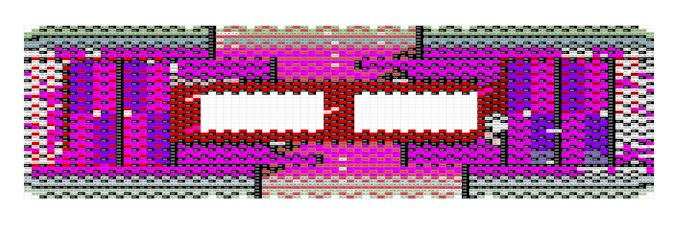
sTR4 socket pin layout on TRX40
AMD states that even though both sockets have the same 'keying' (the plastic bits that stop you installing wrong processors), they have engineered the ID pins such that using a new processor in an old motherboard, or vice versa, will just cause the system not to boot, rather than break it. We're going to take AMD's word for that, rather than potentially break an expensive CPU/motherboard combo.
AMD TRX40 And The Realtek ALC4050HD Audio Codec
All of the twelve TRX40 models at launch include a Realtek ALC1220 HD audio codec (S1220 for ASUS models), but the vast majority of the twelve also include a Realtek ALC4050H codec. We thought this was odd, so reached out to all of the vendors to find out what was going on. Turns out something really interesting.
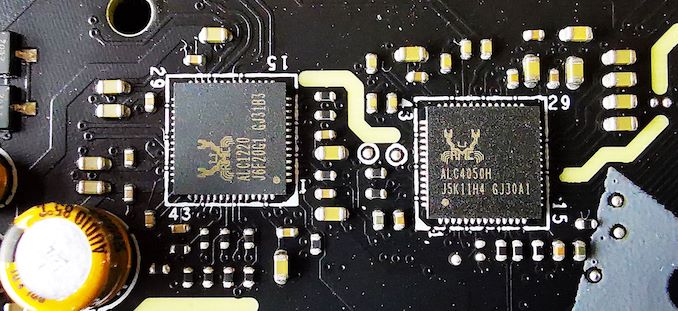
Realtek ALC1220 and ALC4050H audio codecs on the MSI Creator TRX40
It turns out that AMD did not include any onboard passthough audio in the chipet. That means that all the motherboard vendors that are using a Realtek HD audio codec for the rear audio have had to include the ALC4050H audio codec to bridge the USB to the I2S. The Realtek ALC4050H is used to integrate a bridge between the chipset and USB 2.0 to give the Realtek ALC1220 all the necessary connectivity to the onboard audio. Most of the boards in the stack use the ALC4050H codec to power the 3.5 mm microphone input on the rear panel, as well as the front panel audio as not to waste its capability.
Naturally, we asked AMD about this. The official response from AMD reads
The TRX40 platform does not support the HD audio interface used on most desktop and mobile processors.
This means that it is down to the vendors to implement a USB audio device (Realtek ALC4050H) to enable use with the HD audio codecs on TRX40 models.
The TRX40 Product Stack: 12 New Motherboards Unveiled
The launch of both the new Threadripper 3000 series processors, the 3970X and 3960X, has brought about a new wave of models on the new sTR4 socket. There are 12 new TRX40 models in total from the four main vendors, ASRock, ASUS, GIGABYTE, and MSI. It's not just a refresh of the older X399 hardware - the TRX40 chipset is a completely reworked design with many benefits including better componentry, more features from the chipset itself, and most notably, the TRX40 chipset is the first HEDT platform to include PCIe 4.0.
With more models expected to be announced over the coming months, below is a list of the current TRX40 product stack at launch on the 25th of November:
| TRX40 Motherboards Available at Launch (11/25) | |||
| Model | Size | Price (Amazon) |
Price (Newegg) |
| ASRock TRX40 Creator | ATX | - | $460 |
| ASRock TRX40 Taichi | ATX | - | $500 |
| ASUS ROG Zenith II Extreme | E-ATX | - | $850 |
| ASUS ROG Strix TRX40-E | ATX | - | $550 |
| ASUS Prime TRX40-Pro | ATX | $450 | $450 |
| GIGABYTE TRX40 Aorus Xtreme | XL-ATX | - | $850 |
| GIGABYTE TRX40 Aorus Master | E-ATX | - | $500 |
| GIGABYTE TRX40 Aorus Pro WIFI | ATX | - | $400 |
| GIGABYTE TRX40 Designare | XL-ATX | - | $630 |
| MSI Creator TRX40 | E-ATX | $700 | $700 |
| MSI TRX40 Pro 10G | ATX | $500 | $500 |
| MSI TRX40 Pro WIFI | ATX | - | $470 |
On the next page is a summary of each board's power delivery system, with each subsequent page containing a brief analysis/rundown of all the individual boards.


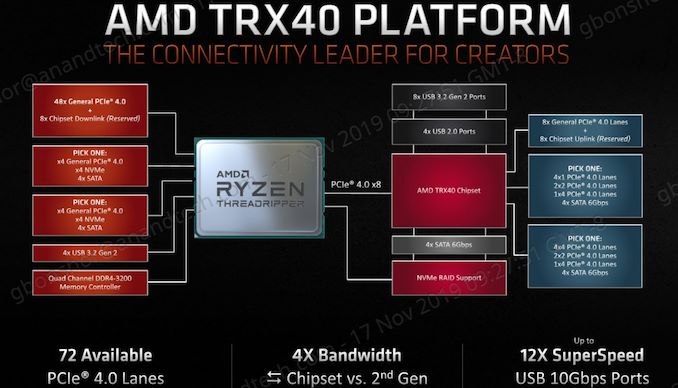
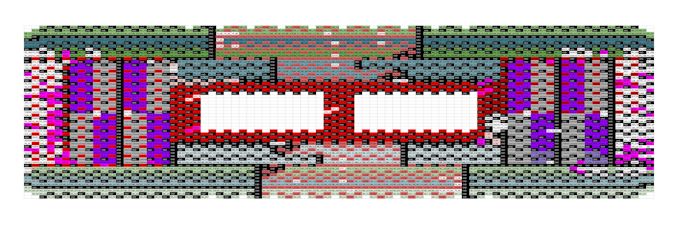








109 Comments
View All Comments
Arsenica - Thursday, November 28, 2019 - link
Something funny about the Gigabyte TRX40 Designare is that they go out their way to not include Thunderbolt branding for the bundled card. They only call it "a 40GB/s GC-Titan Ridge add-in card which allows you to take advantage of exceptionally fast transfer speeds!"YB1064 - Thursday, November 28, 2019 - link
$800 for a motherboard? I don't think any number of Xtreme XXX in the name justifies such a ridiculous price tag.colonelclaw - Thursday, November 28, 2019 - link
Does the lack of Thunderbolt 3 on 11 of the 12 point to it still being too expensive to manufacture? Or something else? Seems odd to me that 8 out of 12 boards has ethernet > 1G, but only a single board has TB3. Doesn't seem very HEDT!gavbon - Thursday, November 28, 2019 - link
Not to mention the single option is via an add-on card. I will reach out and see what I can find outSmell This - Thursday, November 28, 2019 - link
Could TB3 be spec'd-out?
I mean, at 12v/60w (max TB3?) asking too much for cabling/hardware in the ever-ending quest for speed/bandwidth in exchange for heat?
Is the add-on proprietary to AsRock?
eek2121 - Friday, November 29, 2019 - link
Disclaimer, this is going solely off memory and is based off stuff I read somewhere. IIRC The Macbook Pro has 4 thunderbolt 3 ports. More than likely, it's because Intel provides TB3 on the CPU separate from PCIE lanes, whereas AMD only has dedicated PCIE lanes. This means that TB3 uses PCIE lanes on AMD systems.phildj - Sunday, December 8, 2019 - link
The MacBooks Pro (and the 2018 Mac Mini) all run 2 Alpine Ridge (or whatever) controllers off 2x x4 PCIe lanes. The 15/16” version connects to the DGPU using only x8.Digispa - Thursday, November 28, 2019 - link
Thunderbolt, regardless of version number is owned by Intel. I would think that board manufacturers probably don't have to pay a license fee to add it to Intel boards but have to pay a fee for AMD boards they design and sell. It is most likely a cost issue versus a compatible spec issue.eek2121 - Friday, November 29, 2019 - link
Untrue, TB3 has been open sourced. It will be a part of the USB 4.0 standard.dotes12 - Saturday, November 30, 2019 - link
Is it actually going to be called USB 4.0? They were really getting on a roll with USB 3.2 Gen 2×2 SuperSpeed+.